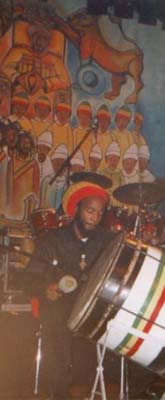rastarfarian nyahbingi drumming
nyabinghi drums nyabingi music nyahbinghi chants rhythms rhythm
rasta
Nyahbingi Music
by Bektemba Nnamdi
 photo
at right: Heidi
Bauer photo
at right: Heidi
Bauer
Music of the Rastafarian
In popular conception, the Rastafari faith is more closely associated
with reggae than with any other music. Undoubtedly, much of roots
reggae does have a solid foundation in the reasonings, or philosophy,
of Rasta. It is a religion that is mystical, spiritual and staunchly
Pan-Africanist; for the most part, roots reggae touts this line:
Seminal reggae artists such as Bob Marley, Peter Tosh, Burning Spear,
Steel Pulse, Black Uhuru and countless others actively cite the
teachings of the Faith on their recordings. However the emphasis
of reggae as the sole representation of Rasta is quite misleading.
In fact, a certain number of “orthodox” locksmen will
contend that Nyahbingi, rather than reggae, is the true Rasta music.
Nyahbingi as a Rastafarian lifestyle
In Rasta overstanding, Nyahbingi is the mystical power of the Most
High to mete justice throughout the universe. Although the genuine
origin of the word that means “she possesses many things”
is Ugandan, as a concept and theology, Nyahbingi has come down to
the Rastaman to signify “death to the oppressors, both black
and white”. Therefore, it is through prayer, music and biblical
reasonings that the Rastaman chants bingi, calling on the forces
of nature to destroy the powers of wickedness.
“…Storm, cyclone, tidal wave and all tempestuous roaring
elements from creation to destroy the wicked nation and set Rastaman
free…”
I hear the voice of the Rastaman say:
Babylon your throne gone down, gone down
Babylon your throne gone down.
Fly away home to Zion
Fly away home.
One bright morning when my work is over
I will fly away home
Lyrics reflect the want for universal justice, the Pan-Africanist’s
estrangement from the Motherland, his yearning to establish a New
Jerusalem in Africa and the ultimate wrath of JAH upon Babylon,
the present-day Euro-colonialists and white supremacists.
 (Image
at right courtesy of Congo Creations) (Image
at right courtesy of Congo Creations)
Nyahbingi Drumming & Rhythms
The musical accompaniment consists of a heartbeat rhythm, played
in 4/4 time on a trinity of drums. Only Rastamen are allowed to
play drums at Nyahbingi. Anyone may play shaka, or shekere.
Thunder: This is the bottom of the bingi ensemble;
there are rarely more than two thunder players at a gathering.
It is a typical looking double-headed bass drum, played with a
mallet. an open tone on “1” and a dampened stroke
on “3”. Occasionally, the thunder player will syncopate
the rhythm.
Funde: Although the funde often resembles a
requinto, the
smallest conga used in Afro-Cuban music, the funde is
actually the middle drum used in Nyahbingi; it
maintains the dominant heartbeat rhythm as the
funde player makes steady, dampened strokes on “1&”
…“3&”; it is thus dually known as the heartbeat
and
has the least improvisational role.
Repeater: The repeater, or akette, is the smallest
and highest
pitched drum. It is somewhat of a single elongated
bongo. The drummer tends to play around “2 e & a”
and “4 e & a”, with a syncopated, rather than
a
backbeat feel. These beats are important to the overall
feel of the Nyahbingi rhythm, but the repeater has a
very improvisational role in bingi because it is seen as
the carrier of spirit.
Shaka: The shekere, which is commonly found
throughout
Africa, the Caribbean Latin America, has a place in
Nyahbingi. The shekere player has a somewhat flexible role: He/she
has been known to play on “1”, “1&”,
“1” and “3” or “1&”…“3&”
[The following should be noted regarding the curious nomenclature
of this instrument—Perhaps the word is a simple corruption
of the proper pronunciation; and there is the possibility that
it is a more calculated allusion to the Zulu word for fire, shaka.
© 2003 Bektemba Nnamdi, all rights reserved.
Listen to a sample of Ras Michael & the Sons
of Negus: Keep Cool Babylon
|